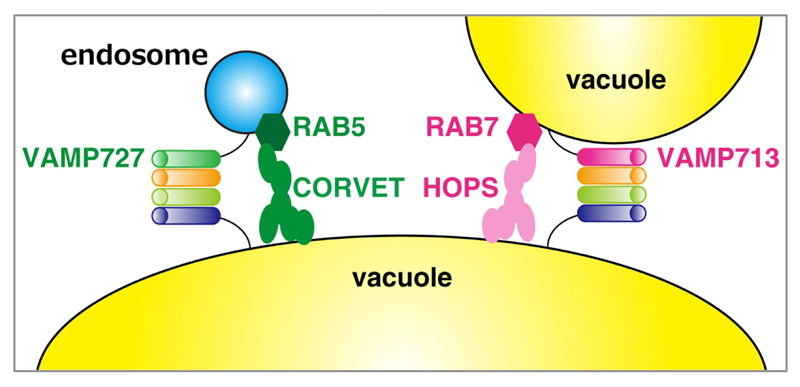Plant vacuoles have a variety of functions, as such they have diverse material transport routes to vacuoles. However, there are still many unexplained aspects as to how these various transport routes evolved and what kind of regulation they are under.
In the current research, a research team led by Professor Takashi Ueda of the National Institute for Basic Biology has shown that a plant-specific vacuole transport pathway is controlled by CORVET, one of the tethering factors acting in the transport pathway to the vacuole.
In animals and yeasts, Rab5/Ypt5 and Rab7/Ypt7 are known as Rab GTPases which function in endosome-vacuolar transport, the former being associated with the CORVET complex and the latter with the HOPS complex, they act as tethering factors that connect transport intermediates or organelles to their target membranes. Although all the constituent subunits of CORVET and HOPS are conserved in plants, their functions in the diversified vacuole transport pathways of plants had not yet been elucidated. Therefore the group first examined the relationship between RAB GTPase and CORVET and HOPS using
Arabidopsis thaliana. As a result, it was found that RAB 5 acts on CORVET and endosomes, and that RAB 7 works on HOPS and vacuolar membranes.
Subsequently, the research group knocked out the functions of CORVET and HOPS and examined the impacts. As a result, regardless of the complex whose function was lost, the embryos were not formed properly and development would stop in the middle of embryogenesis, showing that both CORVET and HOPS are essential for plant survival. Next, as a result of investigating the influence on the transport of proteins to the vacuoles, it became clear CORVET and HOPS work in different vacuole transport routes, and the transport route in which CORVET works has been uniquely acquired by plants during evolution. Subsequently, the research group examined the relationship between SNARE protein, which is responsible for vacuolar membrane fusion, and CORVET and HOPS. As a result, CORVET cooperates with VAMP727, which is a SNARE independently obtained by plants, to fuse endosomes and vacuolar membranes. On the other hand, HOPS has been shown to cooperate with VAMP713, a type of SNARE widely conserved in eukaryotic organisms, to fuse the vacuolar membranes to each other. This showed that a combination of a factor from a common ancestor and a factor newly acquired by plants has resulted in diversification of the process of transportation routes to vacuoles in plants.
The results of this research were published in the online edition of the Proceedings of the National Academy of Sciences on February 20. This research was conducted as a collaborative research by the National Institute for Basic Biology, The University of Tokyo, the Nara Institute of Science and Technology, the International Christian University, and Heidelberg University.

Figure: Model diagram of membrane trafficking factors involved in vacuolar membrane fusion. CORVET performs membrane fusion of endosomes and vacuoles with RAB 5 and VAMP 727 which is a SNARE molecule independently acquired by plants. On the other hand, HOPS controls membrane fusion of vacuoles with RAB 7 and VAMP 713 which is a SNARE molecule widely conserved in eukaryotes.
[Published Journal]
Journal title: Proceedings of the National Academy of Sciences of the United States of America
Publication date: Feb. 20, 2018
Article title: Distinct sets of tethering complexes, SNARE complexes, and Rab GTPases mediate membrane fusion at the vacuole in Arabidopsis
Authors: Kodai Takemoto, Kazuo Ebine, Jana Christin Askani, Falco Krüger, Zaida Andrés Gonzalez, Emi Ito, Tatsuaki Goh, Karin Schumacher, Akihiko Nakano, and Takashi Ueda
DOI:
10.1073/pnas.1717839115





 Figure: Model diagram of membrane trafficking factors involved in vacuolar membrane fusion. CORVET performs membrane fusion of endosomes and vacuoles with RAB 5 and VAMP 727 which is a SNARE molecule independently acquired by plants. On the other hand, HOPS controls membrane fusion of vacuoles with RAB 7 and VAMP 713 which is a SNARE molecule widely conserved in eukaryotes.
Figure: Model diagram of membrane trafficking factors involved in vacuolar membrane fusion. CORVET performs membrane fusion of endosomes and vacuoles with RAB 5 and VAMP 727 which is a SNARE molecule independently acquired by plants. On the other hand, HOPS controls membrane fusion of vacuoles with RAB 7 and VAMP 713 which is a SNARE molecule widely conserved in eukaryotes.